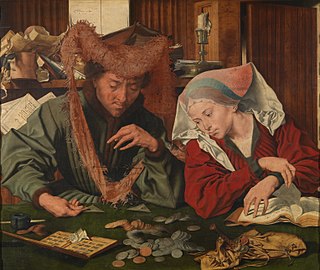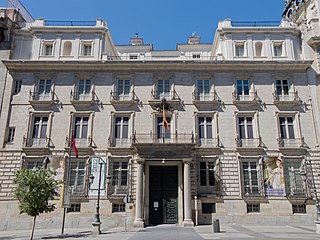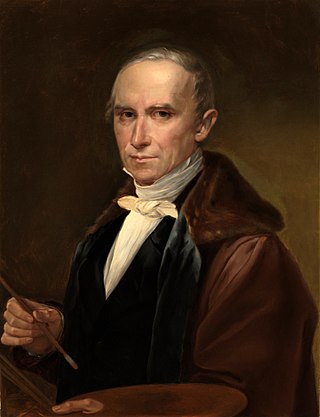
Bartolomeo Carducci (1560 –14 November 1608) was an Italian painter, better known as Carducho, the Spanish corruption of his Italian patronymic.

Bartolomeo Carducci (1560 –14 November 1608) was an Italian painter, better known as Carducho, the Spanish corruption of his Italian patronymic.
Carducci was born in Florence, where he studied architecture and sculpture under Bartolomeo Ammannati, and painting under Federico Zuccari. [1] He assisted Zuccari with the completion of The Last Judgment on the ceiling of the dome of Florence Cathedral. [2] The latter master he accompanied to Madrid, where he painted the ceiling of the Escorial library, assisting also in the production of the frescos that adorn the cloisters of that noted palace. [1]
Between 1604 and 1606, Carducci painted the reliquary altarpieces of San Diego de Valladolid, with the assistance of his brother Vincenzo Carducci. [3] They are now exhibited in National Museum of Sculpture.[ citation needed ]
Among Carducci's pupils was Francisco López.[ citation needed ]
Carducci died in Spain; his brother Vincenzo succeeded him as chief painter to King Philip III of Spain.[ citation needed ]
Most of Carducci's works are in Spain. His Descent from the Cross, originally in Madrid's San Felipe el Real, [1] is now in the Museo del Prado, along with his Last Supper. [4] The Real Academia de Bellas Artes de San Fernando owns his Penitent St. Jerome. [5]

Federico Zuccaro, also known as Federico Zuccari and Federigo Zucchero, was an Italian painter, draughtsman, architect and writer. He worked in various cities in Italy, as well as in other countries such as Spain, France, the Spanish Netherlands and England. He was an important representative of late Mannerism in Italian art.

The Museo del Prado, officially known as Museo Nacional del Prado, is the main Spanish national art museum, located in central Madrid. It houses collections of European art, dating from the 12th century to the early 20th century, based on the former Spanish royal collection, and the single best collection of Spanish art. Founded as a museum of paintings and sculpture in 1819, it also contains important collections of other types of works. The numerous works by Francisco Goya, the single most extensively represented artist, as well as by Hieronymus Bosch, El Greco, Peter Paul Rubens, Titian, and Diego Velázquez, are some of the highlights of the collection. Velázquez and his keen eye and sensibility were also responsible for bringing much of the museum's fine collection of Italian masters to Spain, now one of the largest outside of Italy.

Luis de Morales was a Spanish painter active during the Spanish Renaissance in the 16th century. Known as "El Divino", most of his work was of religious subjects, including many representations of the Madonna and Child and the Passion.

Vincenzio Carduccio was an Italian painter who spent his career in Spain.

Marinus van Reymerswaele or Marinus van Reymerswale was a Dutch Renaissance painter mainly known for his genre scenes and religious compositions. After studying in Leuven and training and working as an artist in Antwerp, he returned later to work in his native Northern Netherlands. He operated a large workshop which produced many versions of mainly four themes: the tax collectors, the money changer and his wife, the calling of Saint Matthew and St. Jerome in his study.

Francesco Trevisani was an Italian painter, active in the period called either early Rococo or late Baroque (barochetto).

The Real Academia de Bellas Artes de San Fernando, located on the Calle de Alcalá in the centre of Madrid, currently functions as a museum and gallery. A public law corporation, it is integrated together with other Spanish royal academies in the Instituto de España.

Giuseppe Baldrighi was an Italian painter of the late Baroque (Rococo) and early Neoclassic periods.

Leandro Bassano, also called Leandro dal Ponte, was an Italian artist from Bassano del Grappa who was awarded a knighthood by the Doge of Venice. He was the younger brother of artist Francesco Bassano the Younger and third son of artist Jacopo Bassano. Their father took his surname from their town of Bassano del Grappa, and trained his sons as painters.

Rafael Tegeo Díaz was a Spanish Neoclassical painter, known primarily for his portraits. His name is sometimes spelled Tejeo.

José de Madrazo y Agudo was a Spanish painter and engraver; one of the primary exponents of the Neoclassical style in Spain. He was the patriarch of a family of artists that included his sons Federico and Luis; and his grandsons, Raimundo and Ricardo.
Félix Castello or Castelo was a Spanish painter of the Baroque period.

Eugenio Caxés was a Spanish painter of the Baroque period.

Antonio de Pereda y Salgado was a Spanish Baroque-era painter, best known for his still lifes.

Salvador Martínez Cubells was a Spanish painter and art restorer, who specialized in history painting and Costumbrismo.

Bartolomé González y Serrano (1564–1627) was a Spanish Baroque painter specializing in portraits that represent a continuation of Renaissance court portrait types practiced by Alonso Sánchez Coello and especially by Juan Pantoja de la Cruz.

Bartolomé Román was a Spanish Baroque painter known for his series of archangels.

The Palacio de la Ribera was the summer residence of Philip III in Valladolid. It was built in the 17th century (1602-1605) as part of a process of urban transformation upon the establishment of the Spanish Court in Valladolid between 1601 and 1606. The palace was situated at the Huerta del Rey neighborhood, located across the Parque de las Moreras on the right bank of the Pisuerga river. The palace grounds extended from the Puente Mayor to Ribera de Don Periáñez del Corral and delimited at both sides by the Pisuerga river and the Camino del Monasterio del Prado. The palace was gradually abandoned until it became part of the destroyed cultural heritage of Valladolid in 1761. Some ruins of the building are still preserved.

Manuel Domínguez Sánchez was a Spanish painter and illustrator in the Academic style. His early work shows some influence from the Nazarenes. Later, his style came to resemble that of Eduardo Rosales.

José Marcelo Contreras y Muñoz was a Spanish painter and art professor. Largely remembered as a painter of historical scenes, he also created portraits and genre works.